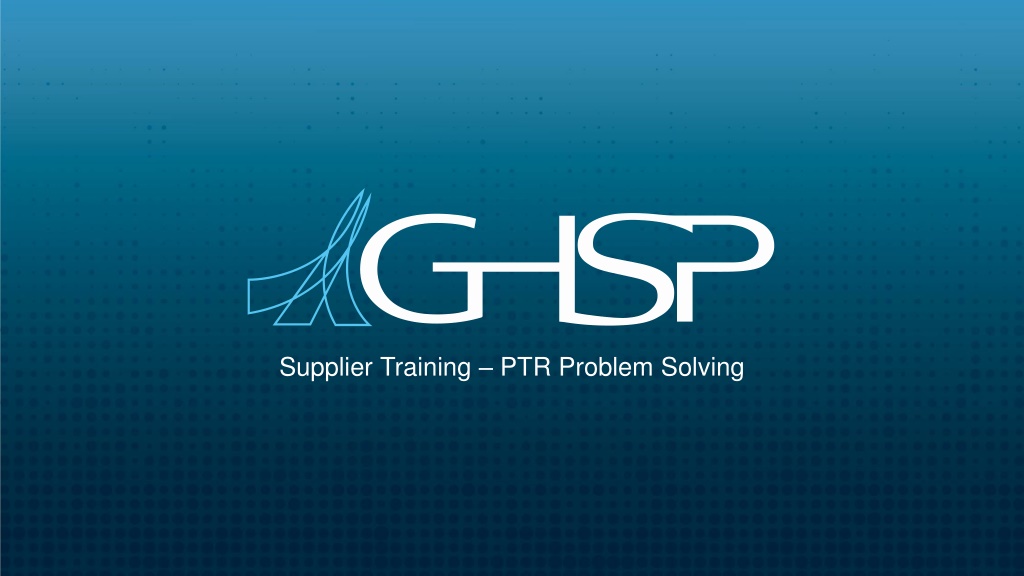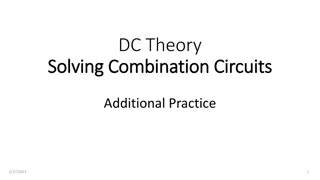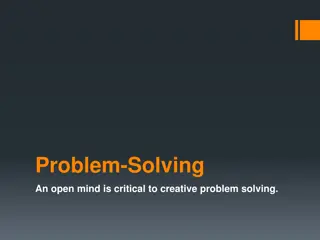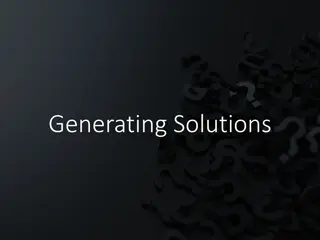Understanding GHSP's PTR Process for Effective Problem Solving
GHSP utilizes PTRs to address customer complaints, internal issues, supplier issues, quality defects, delivery problems, and customer service issues. Learn about the purpose of PTRs, what they are not, and the detailed process involved in tracking and resolving problems effectively.
Download Presentation

Please find below an Image/Link to download the presentation.
The content on the website is provided AS IS for your information and personal use only. It may not be sold, licensed, or shared on other websites without obtaining consent from the author. Download presentation by click this link. If you encounter any issues during the download, it is possible that the publisher has removed the file from their server.
E N D
Presentation Transcript
Supplier Training PTR Problem Solving GHSP Confidential
P T R Problem Tracking & Resolution GHSP Confidential
What is a PTR?? PTRs are used by GHSP to address the following: Customer Complaints Internal Issues Supplier Issues Quality Defects Delivery Issues Customer Service Issues GHSP Confidential
What a PTR is Not!! What a PTR is NOT!! A way to punish suppliers A way for GHSP to make money To be ignored GHSP Confidential
PTR: Problem Tracking and Resolution The PTR Form Header & General Information GHSP Confidential
PTR: Problem Tracking and Resolution The PTR Form Supplier and Issue Details GHSP Confidential
Header and General Information GHSP Confidential
Supplier Details GHSP Confidential
Issue Details Types of Failure Mode include: 1. Dimensional issues 2. Excessive Flash 3. Appearance 4. No Packing Slip 5. Qty. of Parts Received Incorrect GHSP Confidential
Issue Details contd Details of the Failure Mode allows the originator of the PTR to provide more detail of the issue GHSP Confidential
Issue Details contd If an 8D is required, the initial response to the PTR must include a 3D: 1. Team Members 2. Problem Statement 3. Details of Containment Remember: Initial response must be submitted within 24 hours of receiving the PTR. GHSP Confidential
Issue Details contd Issue Types include: 1. Quality Issue 2. Delivery Service Issue 3. Customer Service Issue GHSP Confidential
Issue Details contd GHSP Confidential
Issue Details contd GHSP Confidential
Issue Details contd GHSP Confidential
Issue Details contd Severity Level: A. Any quality spill that affects GHSP s performance with a customer. B. One of the following: 1. Repeat issue within 6 months 2. Caused GHSP downtime 3. Significant disruption to GHSP operations C. Any incident not fitting criteria A or B at the discretion of GHSP SQE or PQE D. Informational or warning only, line accumulations for charge back GHSP Confidential
How PTRs affect the Supplier Scorecard How PTRs affect the Supplier Scorecard PTR Severity Description of Severity Affect on Scorecard Any quality spill that affects GHSP s performance with a customer. A 10 Points deducted One of the following: 1. Repeat issue within 6 months 2. Caused GHSP downtime 3. Significant disruption to GHSP operations B 5 Points deducted Any incident not fitting criteria A or B at the discretion of GHSP SQE or PQE C 3 Points deducted D Informational or warning only 0 Points deducted Proactive notification from the supplier when GHSP has not built the defective product P 0 Points deducted GHSP Confidential
Issue Details contd Disposition may include: 1. GHSP Sort / Rework 2. Supplier Sort / Rework at GHSP 3. Return to Supplier 4. Scrapped at GHSP 5. GHSP Will Use GHSP Confidential
GHSP Expectations from Suppliers Immediate communication with the PTR originator, preferably by phone. If the originator cannot be reached, contact should be made with the PQE or SQE. Contact must be made within 24 hours of receiving the PTR. Early Communication = Higher Confidence that the issue is taken seriously GHSP Confidential
GHSP Expectations from Suppliers When required (within 24 hours): Containment plan Method of Containment Verification of Containment Effectiveness Timing of Containment Actions Set up any sorting/rework operations at GHSP Set up any sorting/rework operations at the supplier s facility Issue RMA number for the return of any suspect product Notification of any in-transit material subject to containment Method of certification of product (box label with PTR number, part markings, etc.) If an 8D is required, then an initial 3D must be submitted within 24 hours GHSP Confidential
GHSP Contacts Initial Response and Containment: PTR Originator Initial 3D Submission: PTR Originator AND Plant SQE Final 8D Submission: Plant SQE Supplier Quality Engineers Grand Haven: Jeff Cherry Hart: Matt Lozen Mexico: Chris Collier China: Wesley Wei GHSP Confidential
Questions? GHSP Confidential
Problem Solving Process The Discipline Approach GHSP Confidential
Eight Parts of an 8D These are the same parts of the D1. Establish the team 3D that is required to be D2. Describe the problem submitted within 24 hours of receiving a PTR with the 8D D3. Contain the problem requirement. GHSP Confidential
The Eight Parts of an 8D D1. Establish the team D2. Describe the problem D3. Contain the problem D4. Find, define, and verify root cause(s) and escape point(s) D5. Choose and verify permanent corrective action(s) for both root cause and escape point D6. Implement and validate permanent corrective actions (PCAs) D7. Prevent recurrence of problem and similar problems. Identify systemic improvement opportunities. D8. Congratulate your team! GHSP Confidential
D1.) Establish the Team Identify the Champion Typically the customer Quality Engineer Select the team A team is a number of individuals working together as a cohesive unit toward a common goal It is important that the team consists of a cross-functional group including persons from manufacturing, processing, and quality. The team should always include operators (from each shift, if applicable). Together Everyone Achieves More GHSP Confidential
D2.) Describe the Problem The Problem Statement must be described in terms that have the same meaning to everyone involved. Before trying to define the root cause, or jump to solutions, stop and take time to describe the problem, using as much data and facts as you can gather Use IS-IS NOT concept with 5 Ws & 2 Hs (Who What Where When Why How How many Ask: What is Wrong with What? http://www.hillsborococ.org/storage/post-images/what-can-i-do.jpg?__SQUARESPACE_CACHEVERSION=1404264319313 Then ask: Do we know why this is happening? If the answer is No , then the What is wrong with what is your Problem Statement. If the answer is Yes , repeat the question What is wrong with what until reaching the statement where the cause is unknown A problem well stated is a problem half solved. -Charles Kettering GHSP Confidential
D2.) Describe the Problem http://www.moodjuice.scot.nhs.uk/images/Image2.gif Successful identification of a problem s root cause depends upon the accuracy of the problem description! The problem description data should provide the basis for testing the cause of the problem. Example: Pin gage would not pass fully through part 5.00mm (+/-0.1mm) ID of P/N 12345123 mounting hole is undersize by up to 0.2mm on 19 pieces measured with pin gage. A problem well stated is a problem half solved. -Charles Kettering GHSP Confidential
D3.) Contain the Problem Interim Containment Action: An action that prevents the symptoms resulting from one or more problems being experienced by the customer. Define and implement containment actions to isolate the problem from reaching the customer. Containment actions are short term and may be costly. Examples include: Quarantine batches of stock Temporary inspection stages Temporary rework (if approved) Temporary training Product recalls GHSP Confidential
D3.) Contain the Problem Verify the effectiveness of the Interim Containment Action(s), and ensure that it does not create other problems and/or concerns. Ensure that responsibilities for the Interim Containment Action(s) are clear. Will the Interim Corrective Action(s) last until Permanent Containment Action(s) are implemented? How will OK parts be identified? Document the Interim Containment Action(s). GHSP Confidential
D3.) Contain the Problem Interim Containment Action attacks the symptom is closely monitored while being applied results are documented is well thought out and verified is replaced by Permanent Corrective Action (at D6) adds cost GHSP Confidential
D4.) Root Cause Analysis and Escape Points Use Problem Solving Tools to identify the most likely cause of a problem IS IS NOT Process Flow Diagram Cause and Effect Diagram (Fish Bone) PFMEA http://thumbs.dreamstime.com/t/root-cause-analysis-chart-keywords-icons-53460291.jpg Identify the potential escape point of a problem Verify the root cause and escape point of a problem GHSP Confidential
D4.) Root Cause Analysis and Escape Points There are three components of Root Cause Analysis Occurrence Root Causes Causes relating to the manufacturing process that allowed the problem to occur. Escape Points Causes relating to why the problem was not detected by control points, thus reaching the customer. Systemic Root Causes Inadequate design and/or validation of processes and/or product Ineffective DFMEA and/or PFMEA Lack of participation by key individuals during the advance product development/planning process GHSP Confidential
D4.) Root Cause Analysis and Escape Points Terminology Related to the Root Cause and Escape Point Possible Cause: Any cause frequently identified on the Cause & Effect diagram that describes how an effect may occur. Most Likely Cause: A theory, based on available data, that best explains the problem description. Root Cause: A verified cause that accounts for the problem, verified by making the problem come and go. Escape Point: The earliest location in the process, closest to the root cause, where the problem could have been detected GHSP Confidential
D4.) Root Cause Analysis and Escape Points Identify ALL possible causes Ask Why as many times as necessary to drive towards root cause Brainstorm using a Cause and Effect Diagram Investigate what, if anything, changed in the manufacturing process Analyze existing data such as Pareto Charts, Control Charts, Check Sheets, etc. Identify the top few possible causes and develop a plan to investigate each cause independently. GHSP Confidential
D4.) Root Cause Analysis and Escape Points Cause and Effect Diagram (Fish Bone) Note: Method People Material You may change the categories as necessary to suit you problem statement Machine Environment Measurement GHSP Confidential
D4.) Root Cause Analysis and Escape Points Investigate possible causes Determine what type of data should be collected to prove the cause Conduct the study Collect the data Analyze the data Outline conclusions Does the data establish the potential cause as being the reason for the problem? Verify the root cause turn it on and off GHSP Confidential
D5.) Choose Permanent Corrective Action What is the significance of PCA as opposed to ICA? ICA only protects the customer from the effects or symptoms of a problem, but they generally do not eliminate its root cause. Instead, these actions protect the customer from the symptoms of the problem while the problem remains. PCA, on the other hand, is the best action that eliminates the root cause of a problem. The PCA removes the problem's symptoms by removing the effect on the customer. GHSP Confidential
D5.) Choose Permanent Corrective Action Determine possible Permanent Corrective Action(s) based on Root Cause Verification Ensure that PCA demonstrates the improvement is sustainable over time Analyze the risk associated with the PCA to ensure it will not create additional problems if implemented. Sometimes choices with the greatest benefits carry the greatest risks. Remember: Every change induces new failure modes GHSP Confidential
D5.) Choose Permanent Corrective Action Key Definitions: Verification: The method by which the root cause is confirmed. Passive Verification: Done by observation; look for the presence of the root cause without changing anything. If you can not prove the presence of the root cause variable, then chances are that this is not the root cause. Active Verification: The process where you seek to make the defect come and go using process variables. Validation: Ongoing evidence, with data, that the implemented action is doing what it was intended to do without contributing to a new failure. Validation follows successful verification and will be confirmed using data. GHSP Confidential
D5.) Choose Permanent Corrective Action Verify the PCA Verification provides: A comparison of the effect of the problem with and without the PCA in place Proves, before implementation, that the PCA ensures that the Root Cause of the problem (as defined in D4) is eliminated Proves that the PCA will not introduce new problems GHSP Confidential
D6.) Implement and Validate Permanent Corrective Action Keys to Successful PCA 1. Develop a detailed plan for PCA implementation 2. Analyze the plan to prevent implementation problems from occurring 3. Identify actions to take should things go wrong (contingency plan) Next Step? 4. Submit SREA for implementation 5. Receive SREA approval 6. Implement the PCA! GHSP Confidential
D6.) Implement and Validate Permanent Corrective Action Validate effectiveness of the PCA thru tools such as Paynter Chart and, if necessary, through trials at the customer plant Develop an action plan with responsibility and timing Update affected documents, and provide evidence as requested, such as: DVP&R, DFMEA, PFMEA, Drawings Tool & Gage revisions, Control Plan, Work Instructions Training http://kathyhadleylifecoach.com/wp-content/uploads/2015/05/problem-solved-2.png GHSP Confidential
D7.) Prevent Recurrence of Problem, and Similar Problems It is very important to take time, as a team, to look back at the problem and ask the following questions: Why did it happen in the first place? What lessons can be learned? What changes need to be made to ensure that this and similar problems never happen again? Identify & control process parameters that will impact the product characteristics Work instructions, visual aids Preventative maintenance program How do we keep the process in control? GHSP Confidential
D7.) Identify Systemic Improvement Opportunities Again, take the time, as a team, to look back at the problem and ask the following questions: What was NOT done correctly during the process of developing and launching the part? Is the DFMEA review process robust? Are the affected disciplines involved in the development of the PFMEA and Control Plan? Do we have the right people doing the various functions? Is the training adequate? GHSP Confidential
Questions? GHSP Confidential























